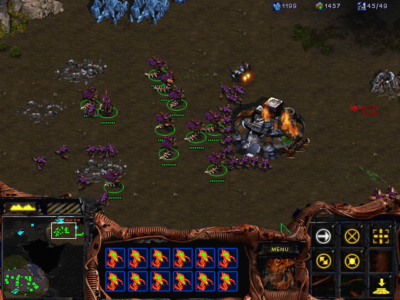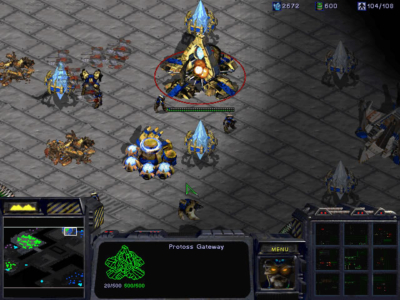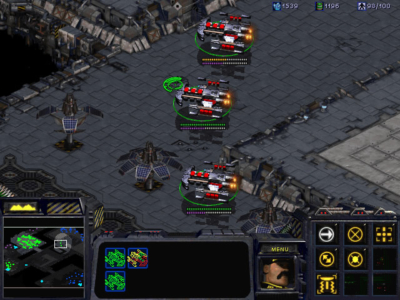
Starcraft
Written by: Stoo
Date posted: December 20, 2004
- Genre: Strategy
- Developed by: Blizzard
- Published by: Blizzard
- Year released: 1998
- Our score: 8
The Real-time Strategy formula, now over a decade old, was already well established by 1998, thanks largely to Westwood’s Dune 2 and Command and Conquer series. Looking down on the battlefield from our godlike perspective above, your mission is to harvest some kind of resource, build a base and factories. Next step is to churn out masses of tanks, or spaceships, or little men with swords. Then, rush your enemy with your forces, smash up his own base and claim victory. Blizzard Studios had already gained success here themselves with the first two titles in the esteemed Warcraft series, setting orcs, elves and humans bashing each other up in a typical fantasy setting.
For a third effort into this genre, however, they decided on a futuristic setting. In a remote sector of space, far from earth, the Terran (that is, human) Confederacy has encountered the hive-like swarm of buglike aliens known as the Zerg. Driven by a single guiding intelligence known as the Overmind, the Zerg are not actually a single race but rather encompass many different species that can be adapted to serve its wishes. They seem hell-bent on rampaging across all worlds they encounter, assimilating any species they find useful and destroying the rest. Rather than presenting a united front against this menace, however, the Confederacy is wracked by civil war. Not a terribly popular regime, other factions seek its overthrowing. To make matters worse, another alien race known as the Protoss has been sighted prowling around space. Ancient and armed with superior technology, the Protoss are an enigmatic bunch, but are at least known to be annihilating all Terran worlds infested with Zerg. Which isn’t good news.
So that’s the setting for what turns out to be quite a story-driven game. First things first, though; how does it look and handle? Well, it should be noted that Blizzard really weren’t shooting for technical innovation here; in fact they never really do. Starcraft is a firmly 2D affair. That said it doesn’t at all look bad; units are well-detailed and animated. It’s all quite pleasing to watch in action, even in lowly 640×480. Rik and I have discussed such matters while pondering how to rate a game’s graphics, and are agreed that well-designed old-fashioned 2D often turns out to age better than some of the clunky grainy attempts at 3D that were seen at the time. Speaking of 3D, Cavedog’s Total Annihilation had indeed already taken steps in that direction. On the one hand, its polygon-based tanks have feel of clanking, earthy realism there that you can never really get with sprites. On the other, they’re somewhat boxy and bland-looking; aesthetic appeal isn’t always determined by the technology on show.
In terms of gameplay, meanwhile, Starcraft does seem to be very much business as usual. Let’s have a quick look at that list again. Resources to pull out of the ground? Check – in this case, gas and mineral crystals. Base building, with factories, research centres etc? Check. Set up a production line to generate ranks of tanks, then throw them at the enemy? Check. Potential for annoying rush tactics – where you abandon positioning, timing, deployment etc and simply swarm and overwhelm with a horde of units? Check.
So far, so formulaic. So what did Starcraft offer to challenge the likes of Red Alert or Total Annihilation? Well, one important factor was the offering of three different armies, each with their own single player campaign. First we have the Terrans, whose’ style should be instantly familiar to any RTS veteran. Armed with old favourites like tanks, obligatory mech-style walkers and missile turrets, they also prowl the skies with fighters and heavy battlecruisers. Terran forces are a fairly flexible bunch with the added bonus of mobile bases to aid in getting out of trouble or capturing new ground.
Next up are the Zerg. They don’t actually use any kind of vehicles or technology; instead basic larvae and drones are ‘morphed; into either structures, or various kinds of warrior creature. Ranging from vicious little Zerglings to airborne Mutalisks, these rake at foes with claws, or shoot acid, spines and spores. Any fans of Warhammer 40k should notice the resemblance to Tyranids (Blizzard seem to have plundered quite a few of Games Workshop’s ideas over the years, but that’s another matter). The Zerg units are generally a bit less powerful than their counterparts from the other races, but their strength is in the capability to quickly generate a sizeable force of creatures and overwhelm their foe with numbers in a short space of time.
Finally in the third campaign we get a chance to control the Protoss. This lot are the most individually powerful; their most basic unit – an energy-blade wielding zealot – can quickly hack his way through a couple of Terran marines. However, they’re correspondingly expensive in terms of resources required. Other units are an eclectic bunch including psionic warriors casting electric storms, artillery that looks like giant robotic woodlice, and flying carriers housing small automated fighters.
When constructing armies in the Warcraft games Blizzard cheated somewhat, in that the two forces looked different but were in fact identical aside from graphics; an Ork Warrior had the exact same stats as a Human. However in this case, the armies are well balanced and yet also wildly different. Learning to use each proficiently takes a bit of practise and is quite enjoyable once you get the hang of it.
Despite these variations, it has to be noted that much of the skill in playing this game is still about setting up the production line, as opposed to clever battlefield tactics. You of course can still try something vaguely clever like attacking from two directions at once to split the enemy forces, but Total War this ain’t. Still, there are a few more features available amidst the rushes. Many units have some kind of ‘special power’ that can be deployed in battle; these include paralysing attacks, teleportation, invisibility, poisoning, burrowing and many many more. Some units in fact lack a direct physical weapon, and instead work in a supporting role with a range of these powers available – it works similarly to how you might expect to use a wizard in a fantasy-setting. This certainly adds an extra dimension to the combat; it can tip the scales if half your foes are suddenly incapacitated or unable to return fire on you. However it can sometimes require the finger dexterity of a concert pianist, to select units and hit hotkeys at the right times to use the powers correctly in the heat of a firefight.
For the most part, battles are fairly fast-paced, close-assault bloodbaths, as opposed to the long-range shelling-fests that Total Annihilation brought us. It doesn’t resemble real war much – or whatever ‘real war’ with giant acid-spitting aliens and robotic woodlice looks like – but is all very easy to pick up. Simple to learn, perhaps hard to master, as the saying goes. Artificial Intelligence is not too excellent, but about part for the course, and the computer uses the units under its control reasonably effectively.
There are a couple of engine-related issues that crop up, though. For one thing, there is no concept of ‘missing’ with a weapon in Starcraft; every shot fired always hits its target. This does maybe work against the effectiveness of hit and run attacks with high-speed units. Secondly, all units must stop moving to attack, be it with claws or ranged attack. It’s a bit silly and unrealistic when you think about it, a fighter hurtling through the air above you, then screeching to a halt just to fire a missile. Oh, and don’t anyone start on ‘well hordes of bug aliens and interstellar spaceships and plasma guns aren’t realistic either’, or I’ll reach out through the internet and slap you silly. There’s a difference between the fanciful and the irrational. Details like this seem to be overlooked by many gamers, so maybe I’m just being fussy here, but I’m pretty sure the older Red Alert was more advanced in these regards, and Total Annihilation certainly was.
It’s worth mentioning that the various units are given a welcome dose of character, though portraits that appear on your interface, and speech clips played as you hand out orders. Most Terran units have US military style personas, as you might expect; so marines shout “yessir!”, “I’m going in!”, “whadda you want?” etc at you, while mech drivers spout military acronyms and the fighter pilot sounds suitably smug. The Zerg meanwhile hiss, spit and roar at you, while Protoss Dragoons solemnly declare “I have returned” and “make use of me”.
At any rate, as I mentioned earlier the single-player campaign is structured to closely follow a fairly decent storyline. This involves infighting and betrayal amidst both the Terrans and Protoss, a fairly tragic case of mistaken priorities while the Zerg infest and invade the worlds of both races. Throughout this a number of characters are caught up in the struggle; either trying to take command or simply doing their best to survive. Apart from starring in the cinematic cutscenes (which set some pretty high standards for Blizzard) and mission briefings, they also turn up in the main gameplay as upgraded “hero” versions of certain units. This all helps make the action a little more involving; you find yourself wanting to win the battle not just for the sake of crushing your foe, but to see what happens next. Will the heroes survive, or be betrayed, or forge an alliance? Okay, we’re not quite talking an epic work of fiction here, but integrating a half-decent bit of storytelling like this can greatly add to the enjoy ability of a game, and there are a few twists and turns along the way to keep you guessing.
The campaign is the side of the game I’m most well-versed in, but there is of course the option of skirmish play (pitched battles with all players starting from scratch), against both AI and human players. These, I confess, I’ve not dabbled in so much. You’ve heard me grumble a bit about rush tactics; the game isn’t too bad for these in the campaign but they seem to be a staple of skirmish. Which I find a bit off-putting. Still, it could just be a case of gaining experience, and it’s worth noting that multiplayer Starcraft is still very popular online or for network play. Especially in Korea, apparently. So it’s obvious Blizzard have done something right here.
On contributing factor is probably that it can be played on just about any PC built in the past eight years. Got a friend round, and feel like some multiplayer action? Dig out that old Pentium lurking in a cupboard, hook it up to your modern rig and Starcraft will be up and running with a minimum of fuss. It also sports a handy feature called a “multiplayer spawn”, essentially allowing you to install multiplayer-only versions of the game on as many PCs as you wish without having to enter a security code. In other words you can legally get all your mates up, running and playing each other on a network after purchasing just a single copy of the game. It’s a welcome gesture from Blizzard, which you don’t see so much of these days.
Back when Starcraft was first released, one magazine review referred to it as ‘a generic data disk for every RTS you already own’. There’s certainly some truth to that; aside from the use of three different armies, there wasn’t much particularly revolutionary about Starcraft. Playing it today, the game does feel pretty basic compared to the 3D brilliance of Homeworld, or the tactical depth and subtleties of the Total War series. Still, it remains an excellent example of old-school RTS gameplay, tweaked and polished and a very high standard. Its closest competitor for the title of ‘Usurper to C&C’s throne’ was Total Annihilation; this was technically more groundbreaking, but single-player was a soulless and uninspiring series of pitched battles. So to this day, Starcraft remains highly entertaining; you might not be plotting intricate battlefield manoeuvres against your foe, but you should enjoy watching the siege tanks let rip, or a host of Zergling claw their way through a base. Let’s face it – we don’t want every single strategy title to contain vast amounts of detail. So for relatively straightforward tank-on-alien action, Starcraft is still a favoured choice.





 Posts
Posts